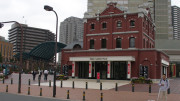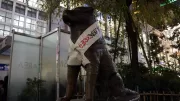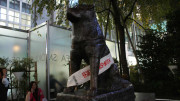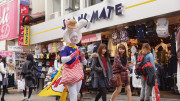The Shibuya district surrounds Shibuya Railway Station, one of the busiest train stations in the world. An estimated 2.4 million people pass through Shibuya’s turnstiles every weekday. However, Shibuya isn’t Tokyo’s busiest station—Tokyo, Shinjuku, and Ikebukuro usually handle even more passengers.
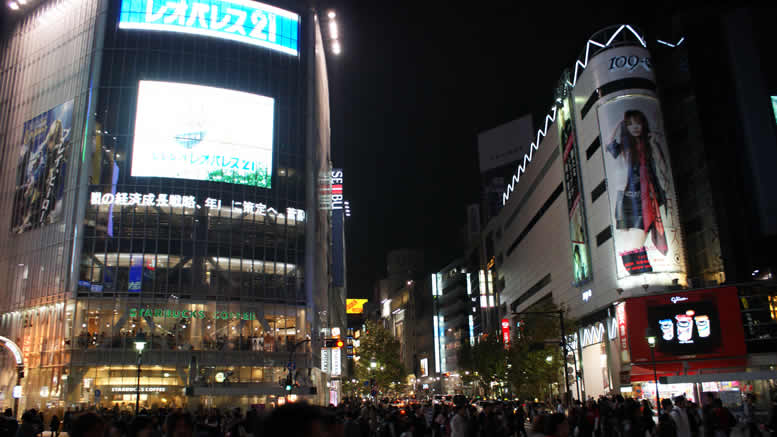
One of the most recognisable images of Tokyo is the incredibly busy scramble crossing outside Shibuya Station. This huge four-way intersection is the gateway to Centre Gai, Shibuya’s bustling shopping district. The crossing has been heavily featured in advertising, as well as in films like Lost in Translation and The Fast and the Furious: Tokyo Drift, all showcasing the striking scene of people flooding the intersection beneath massive neon signs and video screens.
Adding to the spectacle is the sound—blaring J-pop music that echoes through the intersection, competing with traffic noise and digital billboards. If the crowds and blinding lights don’t disorient you, the sound might! Several video screens pump out advertising at full volume, trying to outdo one another. Crossing this intersection is an experience in itself, as people pour from all directions across the zebra crossings.
For a calmer moment, just outside the station is a small square overlooking Centre Gai, known as Hachiko Square. It’s named after a loyal dog who has become an urban legend in Shibuya. The story goes that Hachiko returned to the same spot every day to wait for his owner, who had died at work and never came home. Undeterred, Hachiko kept returning daily, becoming a symbol of loyalty. A statue now stands in his honour, close to where he waited all those years. The statue is a popular meeting point and symbol of Shibuya. In fact, Hachiko Square even featured in a recent episode of The Amazing Race.
Across the road is Centre Gai itself. Although only around 400 metres long, this vibrant street is packed with shops, karaoke bars, pachinko parlours, cafés, bars, and restaurants. It gets especially busy in the evenings when the crowd comes out to play. Space is used creatively here—many venues span several floors above ground, their presence advertised with long strips of neon and vertical video screens.
Much of the shopping is geared toward the youth market, and fast-changing fashion trends dominate the scene. Major shopping complexes like Shibuya 109, Seibu Department Store, and Hands are popular destinations. Hands (formerly Tokyu Hands) is a unique mix of hardware, crafts, and gift store, offering everything from power tools to handbags. The Shibuya branch is the original and one of the largest, with seven floors of retail space. Another notable department store in the area is Takashimaya, whose Shibuya store is the company’s largest.
To the west of the station lies Dogenzaka, a large entertainment district brimming with restaurants, bars, pachinko parlours, and themed love hotels—perfect for a quirky romantic night out.
Koen Dori is another popular shopping street, home to the Marui Department Store. This street leads to the Yoyogi National Stadium, built for the 1964 Tokyo Olympics. The surrounding parks are fantastic for people-watching, especially on Sundays, when young people gather to show off their fashion and makeup. It’s also a popular spot for up-and-coming J-pop and rock bands to perform, particularly during cherry blossom season.
Leading off from Yoyogi Park is Takeshita Street in Harajuku—a must-visit for anyone fascinated by the more eccentric side of Japanese youth fashion. This narrow lane is always packed with thousands of shoppers exploring tiny boutiques selling bold and quirky outfits.
For a cultural experience, the Meiji Jingu Shrine is nearby and well worth a visit. If high-end fashion is more your thing, check out Omotesando Avenue, home to many of Shibuya’s most luxurious boutiques.
Shibuya Station is served by several lines operated by JR, Tokyo Metro, Tokyu, and Keio railway companies. The most popular lines here are JR’s Yamanote Line and the Tokyo Metro Ginza Line (G01). The Narita Express also stops at Shibuya, offering convenient access to Narita Airport. Meanwhile, Yokohama is a little over 30 km southwest of Shibuya Station via the JR Shonan–Shinjuku Line.

